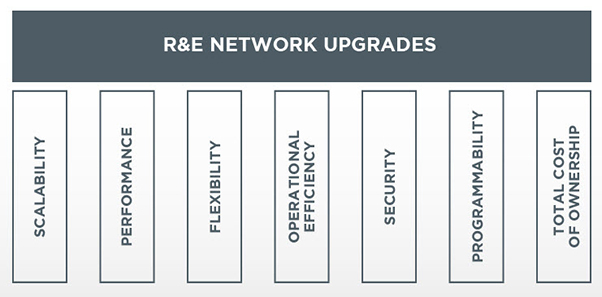7 key considerations when evolving your R&E Network

Vinicius Santos is a Vertical Marketing Consultant at Ciena.
Digital content is an essential part of students’ and researchers’ lives. With streaming media becoming a ubiquitous learning and entertainment application, the facilitation of the education experience has moved to the cloud. With scientific applications and large-scale data sharing consuming more and more of the R&E network bandwidth, connectivity is expected to be reliably delivered anywhere, at any time, on any device.
This broad profile of network applications is just a part of the challenging environment that the R&E campus and network operators are facing. In addition to maintaining current network applications and requirements, operators are expected to adapt to the requirements of new technologies like Augmented Reality and Virtual Reality as well. The constant pressure to reduce system costs while increasing capacity and providing new services are among operators’ top initiatives, if not at the top of the list.
Working with R&E network operators around the world, we have found several fundamental pillars to consider in R&E network evolution planning. These pillars are important, not only for the long-term, but also should be taken into consideration before every upgrade or new project.

Scalability
Demand for network bandwidth is not slowing. R&E network operators have to be thinking in terms of Petabytes and even Exabytes of information being created and transferred by researchers all around the globe. Also, classroom technology, learning collaboration platforms, and student data consumption on campus will continue to compete for more and more capacity resources and become increasingly sensitive to performance impacts. While bandwidth used to seem endless, un-optimized fiber capacity is already leading to bandwidth shortages. The ability to quickly and simply scale network capacity is fundamental. Network operators will need to be prepared to grow network connectivity and interfaces from 100G to 200G, 400G and multiple Terabits regularly, a feat nearly impossible with the constraints of today’s networking approach.
Network operators will need to be prepared to grow network connectivity and interfaces from 100G to 200G, 400G and multiple Terabits regularly, a feat nearly impossible with the constraints of today’s networking approach.
Performance
One of the most prevalent shifts in the network traffic profile has been the change from burstable to real time. Video streaming applications and collaboration tools are much more sensitive to latency and jitter. New technologies like Augmented and Virtual Reality are an important part of the evolution of education, with discovery becoming common in the classroom and the research labs. The evolved R&E network will have to deliver a significantly higher level of capacity and performance to keep up.
Flexibility
The commercialization of application virtualization, software orchestration, and predictive learning has revolutionized network control and flexibility. Static networks are no longer feasible to support the ever-increasing pace of new applications, protocols, and tools. The evolved network needs to be adaptive and responsive to requirements we know today, as well as requirements we haven’t yet imagined. The ability of R&E networks to quickly provide new features and functionalities within and across network domains will be essential to serve the R&E community’s evolving needs and ensure R&E networks continue to support leading network technology innovation.
Operational Efficiency
R&E network budgets and resource growth will remain fairly flat while service demands continue to increase. The ability of R&E campus and network operators to provide more services, faster and at an optimized cost, should also be taken into consideration when planning the next generation R&E network. The evolved R&E network must be feature-rich while minimizing operational costs, reducing complexity, and optimizing operational team resources. The next generation network must be aware, intelligent, and predictive, freeing up scarce operational resources to focus on higher level tasks.
Security
Data security is an increasing concern in the R&E community. Guaranteeing the availability, integrity, and confidentiality of the data used by the R&E community is a critical mission for any network operation. The evolved R&E network must have the ability to secure data in a dynamic environment across a variety of applications. The next generation network will require the ability to intelligently detect and respond to ever-changing threats.
Programmability
The commercialization of Software Defined Networking (SDN) has made the “openness” and “programmability” of networks more attainable and made the ability to provide user-driven on-demand services a reality. We can now change the network behavior, provision network changes, and provide virtualized network services via software orchestration. An evolution plan should consider a phased implementation that enables programmability for the most immediate needs and creates a roadmap to increase the use of multi-layer software control to virtualize a majority of the traditional network elements. Do note that we are still in the early stages of this new era and not all “openness” is created equal.
Total Cost of Ownership
As more network functionality moves from hardware to software, the CAPEX/OPEX ratios of networks will shift. Today’s network approach places a heavy emphasis on individual implementation cost. A total cost of ownership view must take into account the ongoing cost to manage and maintain the network, the cost of space and power, and the cost impact of new services. An evolved network will leverage software and increased utilization of application servers. While CAPEX is driven down, OPEX will increase due to the recurring licensing model typical with software-based services. While the upfront impact may seem high, consider the longer-term reduction in CAPEX and OPEX to facilitate new locations and new services.
These seven pillars should inform every operator’s decision-making outlook when it comes to network upgrades; and not just the big ones. The core question to ask is if all these pillars are being taken into consideration for every new investment that’s happening in the network. Each investment can either make life simpler or more challenging, the ultimate goal being to provide the essential services the R&E community needs.
These seven pillars should inform every operator’s decision-making outlook when it comes to network upgrades; and not just the big ones.
Want to learn more about how you can adopt the seven pillars strategy for your network? Talk to our Ciena team to understand how our hardware, software, and services portfolio can help your network to evolve.





